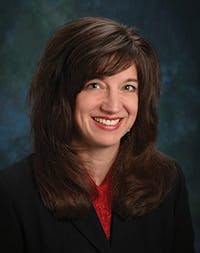The American Industrial Hygiene Association is celebrating its 75th year of protecting worker health and serving the industrial hygiene profession. Based in Falls Church, Va., AIHA represents 10,000 occupational and environmental health professionals – more than half of whom are certified industrial hygienists – in 75 chapters across the country.
But it's not just the 75th anniversary of the association. When members gather May 31-June 5 in San Antonio for the American Industrial Hygiene Conference and Exposition, it will mark the 75th year of the annual conference as well.
One of the highlights of the event is sure to be the induction of AIHA's 2014-2015 president, Christine Lorenzo. Lorenzo, who also serves as the AIHce 2014 conference co-chair, brings an impressive resume of professional experience and achievements to the helm of AIHA. The Denver resident served as AIHA's 2012-2013 vice president and received the Rocky Mountain Section's 2005 Industrial Hygienist of the Year Award.
As an OSHA safety and occupational health manager for federal and state operations, Lorenzo works with leaders throughout OSHA Region VIII to establish consistent and credible enforcement programs and provides strategic leadership and direction in implementing enforcement operations.
Just a few weeks before her induction, Lorenzo spoke with EHS TODAY about the past, present and future of AIHA and the industrial hygiene profession.
JC: What are some of the biggest accomplishments of the association/profession over the past 75 years?
CL: Collectively, we've helped to mobilize public opinions, shape social attitudes, influence health-policy decisions and really heighten [and shift] awareness from occupational health to total health and wellness.
Since the inception of our profession, industrial hygienists have been front and center in characterizing hazards and assessing exposures, and more recently in integrating a risk-based decision-making approach in our practice, and communicating risk in the language of our stakeholders and target audiences, which is especially important.
AIHA is a strong, vibrant, financially sound, well-regarded member-focused association, and I'm proud of that. I'm sincerely grateful to our past leadership and our collective membership, and I'm excited about our future. Relative to the next 75 years, we would like to continue to be the resource that [industrial hygienists] and EHS professionals turn to in order to stay current and connected, and in so doing, remain credible.
JC: What are some of the emerging occupational health threats that industrial hygienists must address?
CL: Today's workers face a host of occupational health threats, and some examples of these include occupational exposures to carbon nanotubes and nanofibers, indoor environmental quality and thousands of new chemicals that we couldn't have imagined 75 years ago.
In industrialized countries, I'd like to think we've almost been able to turn the page from byssinosis, which is cotton worker's lung. But now we have new hazards, such as bronchiolitis obliterans, or popcorn worker's lung.
There are some occupational hazards that are still as relevant today as they were 75 years ago, and a classic example is silica. Crystalline silica exposure in industry continues to be a serious health risk to workers, 77 years after the 1936 congressional investigation into the Gauley Bridge Hawk's Nest Tunnel tragedy, which resulted in an estimated 1,500 to 2,000 workers dying from silica exposure.
Some [threats] are emerging and some are enduring. Silica, asbestos, benzene and lead are just a few of the enduring occupational health hazards that the profession continues to be challenged with.
JC: What is AIHA's position on OSHA's proposed electronic-reporting rule?
CL: While AIHA supports the use of technology that would make the reporting requirements much easier and timelier, AIHA is more concerned that the data collected is accurate and meaningful.
AIHA acknowledges the concern that requiring electronic reporting and posting the data online could result in some employers underreporting injuries and illnesses.
AIHA has some concern on how shifting resources from prevention activities to data management may impact workplace safety. AIHA also realizes that some stakeholders have expressed concern that public posting of the data may result in concerns related to business trades secrets.
And on the other hand, there are some AIHA members who believe that posting of the information would result in employers' ability to compare their injury and illness rates with similar employers, providing information that may result in some employers increasing efforts to protect workers. So this is a difficult question to answer.
AIHA believes that whether or not the data is publicly available is less critical than having accurate data to anticipate and prevent future injuries and illnesses.
continued pg 2
JC: Which safety and health issues would the association like to see OSHA address next, either through regulatory action or increased enforcement or outreach?
CL: Obviously, there are numerous issues that need to be addressed in order to improve worker health and safety. However, the regulatory and legislative process plays a huge role in whether or not any of these issues receive attention.
The biggest obstacle, undoubtedly, is limited resources for enforcement, compliance assistance and standard-setting.
As AIHA looks ahead, we believe the No. 1 issue for our members in worker protection is updating the permissible exposure limits, the PELs. Using existing exposure limits – some of which are more than 40 years old – is a huge concern to industrial hygienists in their efforts to protect workers.
In addition to updating the PELs, AIHA believes that enacting some form of an injury and illness program standard is an important tool that should be put in place.
On the enforcement side, AIHA believes that criminal penalties are outdated.
Along with enforcement and compliance assistance, outreach is an important part of the equation. An educated employer makes the workplace healthier and safer for everyone. In the end, adequate resources are needed to do all of these things – standard-setting, enforcement and compliance assistance – and AIHA and our members stand ready to assist the agency in any of these areas.
JC: What is AIHA's position on the proposed budgets for OSHA, MSHA and NIOSH?
CL: It's very easy to continually criticize the lack of adequate resources for occupational health and safety. In the case of OSHA, MSHA and NIOSH, it's obvious that appropriations have not kept up with the need to protect workers – yet nearly every agency and department of the federal government could say the same thing. Therefore what we must do is work to have more resources appropriated but also work to spend what resources we have more effectively.
Both OSHA and MSHA are having difficulty in providing adequate enforcement and compliance assistance because of limited resources. Is there a way for industrial hygienists and other occupational health and safety professionals to lend more assistance? There's no clear answer, but it might be worth taking a closer look.
As for NIOSH, AIHA is very concerned that the institute is not receiving adequate dollars. NIOSH is the only federal agency doing occupational health and safety research, and NIOSH's research is instrumental in determining many of the issues undertaken by OSHA and MSHA, including exposure limits, protections afforded through regulations and rules and, just as important, the training of occupational health and safety professionals. The institute needs to be funded adequately.
The bottom line is that AIHA – along with other occupational health and safety organizations – must work to educate lawmakers of the importance of the work carried out by OSHA, MSHA and NIOSH, and only then can we be assured of adequate resources appropriated. Then it will be up to the three agencies to spend those funds wisely.
JC: What would you like to be known for during your tenure at AIHA?
CL: I'll give you four bullet points:
- Fostering the best, most inclusive, most transparent communication and interaction – elevating our global conversation.
- Developing new and nurturing existing relationships that will result in greater tangible benefit to our joint memberships practicing globally.
- Strengthening the technical and leadership fabric between the generational leadership and luminaries throughout the organization, and paving the way for future luminaries to actually see themselves as luminaries within the profession.
- And last, getting K-12 and college-university students energized about the science of protecting and enhancing the health and safety of people at work and in their communities.

